Bayonet
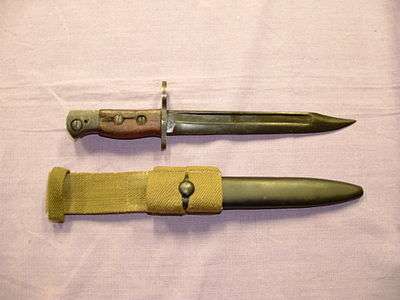
A bayonet (from French baïonnette) is a knife, sword, or spike-shaped weapon designed to fit in, on, over or underneath the muzzle of a rifle, musket or similar weapon, doubling the weapon as a spear.[1] In this regard, it is an ancillary close-quarter combat or last-resort weapon. Some modern bayonets, such as the one used on the British SA80 assault rifle, can be used as wire cutters when combined with their scabbards. Knife-shaped bayonets—when not fixed to a gun barrel—have long been utilized by soldiers in the field as general purpose cutting implements.
Early history

The term bayonette dates back to the end of the 16th century, but it is not clear if bayonets at the time were knives that could be fitted to the ends of firearms, or simply a type of knife. For example, Cotgrave's 1611 Dictionarie describes the Bayonet as "a kind of small flat pocket dagger, furnished with knives; or a great knife to hang at the girdle". Likewise, Pierre Borel wrote in 1655 that a kind of long-knife called a bayonette was made in Bayonne but does not give any further description.[2]
A possibility is that the bayonet originated as a hunting weapon: early firearms were fairly inaccurate and took a long time to reload, thus a hunter of dangerous animals such as wild boar could easily have been exposed to danger if his bullet missed the animal.[3][4] The bayonet may have emerged to allow a hunter to fend off wild animals in the event of a missed shot. This idea was particularly persistent in Spain where hunting arms were usually equipped with bayonets from the 17th century until the advent of the cartridge era. The weapon was introduced into the French army by General Jean Martinet and was common in most European armies by the 1660s.
The usefulness of such a dual-purpose arm soon became apparent. Early muskets fired at a slow rate (about two rounds per minute when loading with loose powder and ball, and no more than three to four rounds per minute using paper cartridges), and could be both inaccurate and unreliable, depending on the quality of manufacture. Bayonets provided a useful addition to the weapons system when an enemy charging to contact could cross the musket's killing ground (a range of approximately 100 yards/meters at the most optimistic) at the expense of perhaps only one or two volleys from their waiting opponents. A bayonet on a 5-foot (around 1.5 meters) tall musket achieved a reach similar to the infantry spear, and later halberd, of earlier times. The bayonet/musket combination was, however, considerably heavier than a polearm of the same length.
Early bayonets were of the "plug" type.[5] This allowed light infantry to be converted to heavy infantry and hold off cavalry charges. The bayonet had a round handle that slid directly into the musket barrel. This naturally prevented the gun from being fired. In 1671, plug bayonets were issued to the French regiment of fusiliers then raised. They were issued to part of an English dragoon regiment raised in 1672 and disbanded in 1674, and to the Royal Fusiliers when raised in 1685. The danger incurred by the use of this bayonet (which put a stop to all fire) was felt so early that the younger Puységur invented a socket bayonet in 1678 that fitted over the muzzle using a circular band of metal, allowing the musket to be loaded and fired. However, it was not widely adopted at the time.
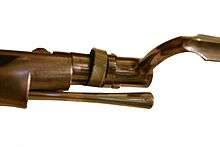
The defeat of forces loyal to William of Orange by Jacobite Highlanders at the Battle of Killiecrankie in 1689 was due (among other things) to the use of the plug-bayonet;[5] and shortly afterwards the defeated leader, Hugh Mackay, is believed to have introduced a ring-bayonet of his own invention. Soon "socket" bayonets would incorporate both ring mounts and an offset blade, keeping the bayonet well away from the muzzle blast of the musket barrel.
An unsuccessful trial with socket or zigzag bayonets was made after the battle of Fleurus in 1690, in the presence of King Louis XIV, who refused to adopt them, as they had a tendency to fall off the musket. Shortly after the Peace of Ryswick (1697), the English and Germans abolished the pike and introduced ring bayonets; and pictures of them are shown in Surirey de St. Remy's Mémoires d'Artillerie, published in Paris in that year. In 1703, the French infantry adopted spring-loaded locking system that prevented the bayonet from accidentally separating from the musket. Henceforward, the socket bayonet became, with the musket or other firearm, the typical weapon of the French infantry. A triangular blade was introduced around 1715 and was stronger than the previous single or double-edged models, creating wounds which were harder to treat due to the propensity of healing scar tissue to pull apart the triangular incision.
The socket bayonet had by then been adopted by most European armies. The British socket bayonet had a triangular blade with a flat side towards the muzzle and two fluted sides outermost to a length of 15 inches (38 cm). However it had no lock to keep it fast to the muzzle and was well-documented for falling off in the heat of battle.[5]
19th century and the multi-purpose bayonet
The 19th century introduced the concept of the sword bayonet, a long-bladed weapon with a single- or double-edged blade that could also be used as a shortsword. Its initial purpose was to ensure that riflemen could form an infantry square properly to fend off cavalry attacks when in ranks with musketmen, whose weapons were longer. A prime early example of a sword bayonet-fitted rifle is the British Infantry Rifle of 1800-1840, later known as the "Baker Rifle" (to this day, no matter what length of the bayonet, British rifle regiments "fix swords").[5] The hilt usually had quillons modified to accommodate the gun barrel and a hilt mechanism that enabled the bayonet to be attached to a bayonet lug. A sword bayonet could be used in combat as a side arm. When attached to the musket or rifle, it effectively turned almost any long gun into a spear or glaive, suitable not only for thrusting but also for slashing.
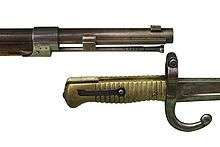
While the British Army eventually discarded the sword bayonet, the socket bayonet survived the introduction of the rifled musket into British service in 1854. The new rifled musket copied the French locking ring system.[5] The new bayonet proved its worth at the Battle of Alma and the Battle of Inkerman during the Crimean War, where the Imperial Russian Army learned to fear it.[5]
In the United States Navy before the American Civil War, bayonet blades were even affixed to single-shot pistols, although they were soon proved useless for anything but cooking.
From 1869, some European nations began to develop new multi-purpose sword bayonets suitable for mass production and for use by police, pioneer, and engineer troops.[6] The decision to redesign the bayonet into a multi-purpose tool was viewed by some as an acknowledgement of the decline in importance of the fixed bayonet as a weapon in the face of new advances in firearms technology.[7] As a British newspaper put it, "the committee, in recommending this new sword bayonet, appear to have had in view the fact that bayonets will henceforth be less frequently used than in former times as a weapon of offence and defence; they desired, therefore, to substitute an instrument of more general utility."[7]
One of these multipurpose designs was the 'sawback' bayonet, which incorporated saw teeth on the spine of the blade.[6] The sawback bayonet was intended for use as a general-purpose utility tool as well as a weapon; the teeth were meant to facilitate the cutting of wood for various defensive works such as barbed-wire posts, as well as for butchering livestock.[1][7][8][9] It was initially adopted by the German states in 1865; until the middle of WWI approximately 5% of every bayonet style was complemented with a sawback version, countries such as Belgium in 1868, Great Britain in 1869 and Switzerland in 1878; (the latter introduced their last model in 1914).[1][7][8][9][10] The original sawback bayonets were typically of the heavy sword-type, they were issued to engineers, with to some extent the bayonet aspect being secondary to the "tool" aspect. Later German sawbacks were more of a rank indicator than a functional saw. The sawback proved relatively ineffective as a cutting tool, and was soon outmoded by improvements in military logistics and transportation; most nations dropped the sawback feature by 1900.[1] The German army discontinued use of the sawback bayonet in 1917 after protests that the serrated blade caused unnecessarily severe wounds when used as a fixed bayonet.[1][9]
The trowel or spade bayonet was another multipurpose design, intended for use both as an offensive weapon as well as a digging tool for excavating entrenchments.[11][12] From 1870, the US Army issued trowel bayonets to infantry regiments based on a design by Lieutenant-Colonel Edmund Rice, a US Army officer and Civil War veteran, which were manufactured by the Springfield Armory.[13] Besides its utility as both a fixed bayonet and a digging implement, the Rice trowel bayonet could be used to plaster log huts and stone chimneys for winter quarters; sharpened on one edge, it could cut tent poles and pins.[13] Ten thousand were eventually issued, and the design saw service during the 1877 Nez Perce campaign.[14] Rice was given leave in 1877 to demonstrate his trowel bayonet to several nations in Europe.[14] One infantry officer recommended it to the exclusion of all other designs, noting that "the intrenching [sic] tools of an army rarely get up to the front until the exigency for their use has passed."[13] The Rice trowel bayonet was declared obsolete by the US Army in December 1881.[14]
The "reach" controversy
Prior to World War I, bayonet doctrine was largely founded upon the concept of "reach"; that is, a soldier's theoretical ability, by use of an extremely long rifle and fixed bayonet, to stab an enemy soldier without having to approach within reach of his opponent's blade.[1][15][16] A combined length of rifle and bayonet longer than that of the enemy infantryman's rifle and attached bayonet, like the infantryman's pike of bygone days, was thought to impart a definite tactical advantage on the battlefield, and military authorities engaged in endless discussions over the supposed advantages of longer rifle/bayonet combinations.[1][16][17][18]
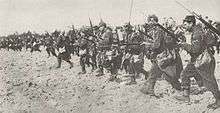
In 1886, the French Army introduced a 52 cm (20 in.)-long quadrangular épée spike for the bayonet of the Lebel Model 1886 rifle, the Épée-Baïonnette Modèle 1886, resulting in a rifle and bayonet with an overall length of six feet (1.83 m). German ordnance authorities responded by introducing a long sword bayonet for the Model 1898 Mauser rifle, which had a 29-inch barrel. The new bayonet, designated the Seitengewehr 98, had a 50 cm (19.7-inch) blade.[17] With an overall length of 5 feet 9 inches (1.75 m), the German Army's rifle/bayonet combination was second only to the French Lebel for overall bayonet 'reach'.[17]
After 1900, Switzerland, Britain, and the United States adopted rifles with barrel lengths shorter than that of a rifled musket, but longer than that of a carbine.[1][19] These new rifles were intended for general use by both the infantry and cavalry.[19] Due to the reduction in barrel length, the overall "reach" of the new short rifles with attached bayonet was reduced.[1] In the case of Britain, this occurred when the British Army adopted a shortened Lee–Enfield rifle, the SMLE, in 1904.[1][19] As a consequence, the German M1898 Mauser rifle and attached sword bayonet was a full eight inches longer than the British SMLE and its P1903 bayonet, which used a twelve-inch blade.[1][20] While the British P1903 and its similar predecessor, the P1888, had proved completely satisfactory in service, a storm of criticism soon arose regarding the effective reach of the new short rifles when equipped with a fixed bayonet.[1][17][19][21] One military writer of the day warned: "The German soldier has eight inches the better of the argument over the British soldier when it comes to crossing bayonets, and the extra eight inches easily turns the battle in favour of the longer, if both men are of equal skill."[17]
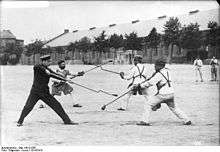
In 1905 the German Army adopted a shortened (37 cm or 14.6-inch) bayonet, the Seitengewehr 98/06 for engineer and pioneer troops, and in 1908, a short rifle as well, the Karabiner Model 1898AZ, which was produced in limited quantities for the cavalry, artillery, and other specialist troops.[22] However, the long-barreled 98 Mauser rifle remained in service as the primary infantry small arm.[23] Moreover, German military authorities continued to promote the idea of outreaching one's opponent on the battlefield by means of a longer rifle/bayonet combination, a concept prominently featured in its infantry bayonet training doctrines.[18] These included the throw point or extended thrust-and-lunge attack.[24] Using this tactic, the German soldier dropped into a half-crouch, with the rifle and fixed bayonet held close to the body.[24] In this position the soldier next propelled his rifle forward, then dropped the supporting hand while taking a step forward with the right foot, simultaneously thrusting out the right arm full length with the extended rifle held in the grip of the right hand alone.[24] With a maximum 'kill zone' of some eleven feet, the throw point bayonet attack gave an impressive increase in 'reach', and was later adopted by other military forces, including the U.S. Army.[24][25]
In response to criticism over the reduced reach of the SMLE rifle and bayonet, British ordnance authorities introduced the P1907 bayonet in 1908, which had an elongated blade of some seventeen inches to compensate for the reduced overall length of the SMLE rifle.[1][16][19][26][27] U.S. authorities in turn adopted a long (16-in. blade) bayonet for the M1903 Springfield short rifle, the M1905 bayonet; later, a long sword bayonet was also provided for the M1917 Enfield rifle.[21]
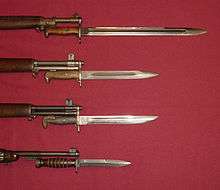
The experience of World War I prompted a complete reversal in opinion on the relative value of long rifles and bayonets in typical infantry combat operations.[20][27][28][29] Whether in the close confines of trench warfare, night time raiding and patrolling, or attacking across open ground, soldiers of both sides soon recognized the inherent limitations of a long and ungainly rifle and bayonet when used as a close-quarters battle weapon.[20][27][28][29] Once Allied soldiers had been trained to expect the throw point or extended thrust-and-lunge attack, the method lost most of its tactical value on the World War I battlefield.[24] It required a strong arm and wrist, was very slow to recover if the initial thrust missed its mark, and was easily parried by a soldier who was trained to expect it, thus exposing the German soldier to a return thrust which he could not easily block or parry.[24][30][31] Instead of longer bayonets, infantry forces on both sides began experimenting with other weapons as auxiliary close-quarter arms, including the trench knife, pistol, hand grenade, and entrenching tool.[28][32]
Soldiers soon began employing the bayonet as a knife as well as an attachment for the rifle, and bayonets were often shortened officially or unofficially to make them more versatile and easier to use as tools, or to maneuver in close quarters.[1][27][28][29] During World War II, bayonets were further shortened into knife-sized weapons in order to give them additional utility as fighting or utility knives.[1] The vast majority of modern bayonets introduced since World War II are of the knife type.[1]
Bayonet charge

18th and 19th century military tactics included the introduction of tactical doctrines using a bayonet fixed on the infantryman's musket, used with massed troop formations.[5] One of the more notable of these was the bayonet charge, an attack by a formation of infantrymen with fixed bayonets, usually over short distances, to overrun enemy strong points, capture artillery batteries, or break up enemy troop formations.
With the advent of the socket bayonet, the pike was in the process of being phased out as infantry could now adequately defend themselves from cavalry without sacrificing firepower per man. The Russian Army used the bayonet frequently during the Napoleonic wars. A Russian tactical precept coined by Russian General Alexander Suvorov was "The bullet is foolish, the bayonet wise". Given Russia's often inadequately trained conscript armies and use of inaccurate smooth-bore muskets, Russian officers preferred to use the bayonet charge instead of musket volley fire where possible.
Despite their effectiveness, a bayonet charge did not necessarily cause substantial casualties through the use of the weapon itself. Casualty lists from several battles in the 18th century showed that in many, fewer than 2% of all wounds treated were caused by bayonets.[33] Antoine-Henri Jomini, a celebrated military author of the Napoleonic period who served in numerous armies during that period, stated that the majority of bayonet charges in the open resulted with one side fleeing before any contact was made. Combat with bayonets did occur, but mostly on a small scale when units of opposing sides encountered each other in a confined environment, such as during the storming of fortifications or during skirmishes in broken terrain.[34] In an age where virtually all combatants have discarded most forms of body armour, bayonet combats would have been particularly horrific affairs when the individual combatants did not have any room to dodge or parry, and hence explains why one side would almost always flee before the two met. Thus, the bayonet was an immensely useful weapon for capturing ground from the enemy, despite seldom actually being used to inflict wounds.
Tactical decline
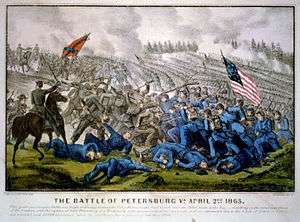
As early as the American Civil War (1861–65) the bayonet was ultimately responsible for less than 1% of battlefield casualties,[35] a hallmark of modern warfare. The use of "cold steel" to force the enemy to retreat was very successful in numerous small unit engagements at short range in the American Civil War, as most troops would retreat when charged while reloading (which could take up to a minute with loose powder even for trained troops). Although such charges inflicted few casualties, they often decided short engagements, and tactical possession of important defensive ground features. Additionally, bayonet drill could be used to rally men temporarily discomfited by enemy fire.[36]
While the overall Battle of Gettysburg was won by the Union armies due to a combination of terrain and massed artillery fire, a decisive point on the second day of the battle hinged on a bayonet charge at Little Round Top when the 20th Maine Volunteer Infantry Regiment, running short of musket ammunition, charged downhill, surprising and capturing many of the surviving soldiers of the 15th Alabama and other Confederate regiments.
The armies of the late 19th century continued to make extensive use of the bayonet for peacetime training and drill. Imperial Russian infantry carried "triangular" bayonets fixed to their rifles on almost all occasions, rather than using the belt attached scabbards of other armies. French troops were issued with very long "sword" bayonets, giving a total reach of six feet when attached to their M1886 Lebel rifles. By contrast the British bayonet of 1903 gave a length of less than four feet and nine inches when fixed on the Lee-Enfield rifle. In 1905 the U.S. Army experimented with a "rod-bayonet" which slid into an attachment under the rifle barrel. The Japanese, Imperial German and Italian armies all developed their separate sizes and patterns of bayonets. Nearly all retained the historic principle of a thrusting spear-like weapon.[37]
The advent of modern warfare in the 20th century further decreased the bayonet's usefulness, although small unit actions still include the use of the bayonet for close-quarter fighting. During the Korean War, the French Battalion and Turkish Brigade conducted bayonet charges against their enemy.[38] United States Army officer Lewis L. Millett led soldiers of the US Army's 27th Infantry Regiment in taking out a machine gun position with bayonets, and received the Medal of Honor for the action. This was the last bayonet charge by the US Army.

In 1995, during the Siege of Sarajevo, French Marine infantrymen from the 3rd RIMA carried out a bayonet charge against the Serbian forces to regain the Vrbanja bridge.[39]
The British Army mounted bayonet charges during the Falklands War (see Battle of Mount Tumbledown), the Second Gulf War, and the war in Afghanistan.[40] In 2004 in Iraq at the Battle of Danny Boy, the Argyll and Sutherland Highlanders bayonet-charged mortar positions filled with over 100 Mahdi Army members. The ensuing hand-to-hand fighting resulted in an estimate of over 40 insurgents killed and 35 bodies collected (many floated down the river) and nine prisoners. Sergeant Brian Wood, of the Princess of Wales's Royal Regiment, was awarded the Military Cross for his part in the battle.[41] In 2009, Lieutenant James Adamson, aged 24, of the Royal Regiment of Scotland was awarded the Military Cross for a bayonet charge whilst on a tour of duty in Afghanistan: after shooting one Taliban fighter dead Adamson had run out of ammunition when another enemy appeared. He immediately charged the second Taliban fighter and bayoneted him.[42] In September 2012, Lance Corporal Sean Jones of The Princess of Wales's Regiment was awarded the Military Cross for his role in a bayonet charge which took place in October 2011.[43]
Contemporary versions
Today the bayonet is rarely used in one-to-one combat.[44][45][46] Despite its limitations, many modern assault rifles (including bullpup designs) retain a bayonet lug and the bayonet is still issued by many armies. Also, the bayonet is still used for controlling prisoners and as a weapon of "last resort."[44] In addition, some authorities have concluded that the bayonet serves as a useful training aid in building morale and increasing desired aggressiveness in troops.[47][48]
Today's bayonets are often multi-purpose knives such as the American M9 which is also an effective fighting knife or the Soviet AKM bayonet which was also a ground breaking survival knife that can be used as a wire-cutter when combined with its scabbard. Some bayonets can also be used as utility knives, bottle openers or throwing knives.[49][50] Also, issuing one modern multi-purpose bayonet/knife is obviously more cost effective than issuing separate specialty bayonets, field knives and combat knives.
Union of Soviet Socialist Republics
The original AK-47 has an adequate but unremarkable bayonet. However, the AKM Type I bayonet (introduced in 1959) was a revolutionary design.[51] It has a Bowie style (clip-point) blade with saw-teeth along the spine, and can be used as a multi-purpose knife and wire-cutter when combined with its steel scabbard.[51][52] This design was copied by other nations and formed the basis of the US M9 bayonet.[51][53] The AK-74 bayonet 6Kh5 (introduced in 1983) represents a further refinement of the AKM bayonet. "It introduced a radical blade cross-section, that has a flat milled on one side near the edge and a corresponding flat milled on the opposite side near the false edge."[51] The blade has a new spear point and an improved one-piece moulded plastic grip, making it a more effective fighting knife.[51] It also has saw-teeth on the false edge and the usual hole for use as a wire-cutter.[51] The wire cutting versions of the AK bayonets each have an electrically insulated handle and an electrically insulated part of the scabbard, so it can be used to cut an electrified wire.
United States
The American M16 rifle used the M7 bayonet which is based on earlier designs such as the M4, M5 and M6 models, all of which are direct descendants of the M3 Fighting Knife and have a spear-point blade with a half sharpened secondary edge. The newer M9 has a clip-point blade with saw-teeth along the spine, and can be used as a multi-purpose knife and wire-cutter when combined with its scabbard. It can even be used by troops to cut their way free through the relatively thin metal skin of a crashed helicopter or airplane. The current USMC OKC-3S bayonet bears a resemblance to the Marines' iconic Ka-Bar fighting knife with serrations near the handle.
Time reported that bayonet training during basic training and usage was discontinued in 2010,[54] however the Washington Post said that Marines still trained with bayonets in boot camp and only said the Army did not conduct bayonet training during the basic training cycle.[55] The Post story did not discuss Infantry AIT training or advanced combat training courses.
People's Republic of China
The AK-47 assault rifle was copied by China as the Type 56 assault rifle and include an integral folding spike bayonet, similar to the SKS rifle.[56] Some Type 56s may also use the AKM Type II bayonet.[56][57] The latest Chinese rifle, the QBZ-95, has the multi-purpose knife bayonet similar to the US M9.
Belgium
The FN FAL has two types of bayonets. The first is a traditional spear point bayonet. The second is the Type C socket bayonet introduced in the 1960s.[58] It has a hollow handle that fits over the muzzle and slots that lined up with those on the FALs 22 mm NATO-spec flash hider.[58] Its spear-type blade is offset to the side of the handle to allow the bullet to pass beside the blade.[58]
United Kingdom
The current British L3A1 socket bayonet is based on the FN FAL Type C socket bayonet with a clip-point blade.[59] It has a hollow handle that fits over the SA80/L85 rifles muzzle and slots that lined up with those on the flash eliminator. The blade is offset to the side of the handle to allow the bullet to pass beside the blade. It can also be used as a multi-purpose knife and wire-cutter when combined with its scabbard.[44] The scabbard also has a sharpening stone and folding saw blade.[44]
Germany
The H&K G3 rifle uses two types of bayonets, both of which mount above the G3s barrel.[60] The first is the standard G3 bayonet which has a blade similar to the American M7.[60] The second is an EICKHORN KCB-70 type multi-purpose knife bayonet, featuring a clip-point with saw-back, a wire-cutter scabbard and a distinctive squared handgrip.[60] For the H&K G36 there was little use of modified AKM type II blade bayonets from stocks of the former Nationale Volksarmee (National People's Army) of East Germany. The original muzzle-ring was cut away and a new, large diameter muzzle ring welded in place. The original leather belt hanger was replaced by a complex web and plastic belt hanger designed to fit the West German load bearing equipment.[61]
Austria
The Steyr AUG uses two types of bayonet. The first and most common is an Eickhorn KCB-70 type multi-purpose bayonet with an M16 bayonet type interface. The second are the Glock Feldmesser 78 (Field Knife 78) and the Feldmesser 81 (Survival Knife 81), which can also be used as a bayonet, by engaging a socket in the pommel (covered by a plastic cap) into a bayonet adapter that can be fitted to the AUG rifle.[62][63][64] These bayonets are noteworthy, as they were meant to be used primarily as field or survival knives and use as a bayonet was a secondary consideration. They can also be used as throwing knives and have a built-in bottle opener in the crossguard.[49][50]
France
The French use a more traditional spear point bayonet; the current FAMAS bayonet is nearly identical to that of the M1949/56 bayonet.[65]
Photo gallery
-

Russian AK-47 bayonet and scabbard.
-
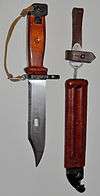
Soviet AKM type II bayonet, multi-purpose knife and wire-cutter when combined with its scabbard.
-

Soviet AKM type II bayonet and scabbard in wire-cutter configuration.
-

Afghan policeman with AKM and AKM Type II bayonet.
-

The US M5 Bayonet and scabbard used with the M1 Garand
-
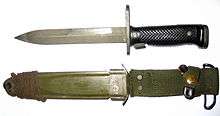
The US M6 bayonet and scabbard used with the M14 rifle
-
M7 Bayonet and M8A1 Sheath used with the M16 rifle
-

Adopted in 1984, the US M9 bayonet and scabbard used with the M16 rifle and M4 carbine.
-
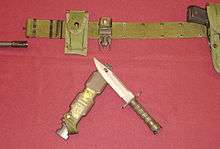
M9 bayonet and scabbard in wire-cutter configuration.
-

M9 bayonet fitted M4 carbine firing during secondary target drills.
-

The USMC OKC-3S Bayonet
-

US Marines at bayonet practice
-
Folding an SKS-type bayonet
-

A Chinese sailor with a Type 56 in 1986. Note the integral folding spike bayonet.
-

Chinese soldier with QBZ-95 rifle and multi-purpose knife bayonet.
-

Indian Army Gurkha with L1A1 (FN FAL) and traditional bayonet
-

Brazilian Army SOF. Note FN FAL type rifles with Type C socket bayonets.
-

Bayonet attached to a British L85A2 rifle. Note the barrel to the left and slot in the blade to attach the wire-cutter scabbard.
-

A British soldier from the Royal Regiment of Scotland with a fixed bayonet on an SA80 rifle, in July 2006.
-

Palace guard at the royal palace, Oslo. Note the G3 type rifle with bayonet over the barrel.
-
Glock field knife/bayonet and its scabbard. The upper crossguard is bent forward and can be used as a bottle opener.
-
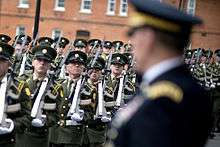
Irish Army Honor Guard. Note Steyr AUG with EICKHORN KCB-70 type multi-purpose bayonet
-

Royal New Zealand Navy Guard of Honour. Note Steyr AUG with American M7 bayonets.
-
French Legionnaire with FAMAS and fixed bayonet.
Linguistic impact
The push-twist motion of fastening the older type of bayonet has given a name to:
- The "bayonet mount" used for various types of quick fastenings, such as camera lenses.
- Several connectors and contacts including the bayonet-fitting light bulb that is common in the UK (as opposed to the continental European screw-fitting type).
- The BNC ("Bayonet Neill-Concelman") RF connector.
- One type of connector for foil and sabre weapons used in modern fencing competitions is referred to as a "bayonet" connector.
In chess, an aggressive variation of the King's Indian Defence is known as the "Bayonet Attack".
The bayonet has become a symbol of military power. The term "at the point of a bayonet" refers to using military force or action to accomplish, maintain, or defend something (cf. Bayonet Constitution). Undertaking a task "with fixed bayonets" has this connotation of no room for compromise and is a phrase used particularly in politics.
Badges and insignias
The Australian Army 'Rising Sun' badge features a semicircle of bayonets. The Australian Army Infantry Combat Badge (ICB) takes the form of a vertically mounted Australian Army SLR (7.62mm self-loading rifle FN FAL) bayonet surrounded by an oval-shaped laurel wreath.[66] The US Army Combat Action Badge, awarded to personnel who have come under fire since 2001 and who are not eligible for the Combat Infantryman Badge (due to the fact that only Infantry personnel may be awarded the Combat Infantryman Badge), has a bayonet as its central motif.
The shoulder sleeve insignia for the 10th Mountain Division in the US Army features crossed bayonets. The US Army's 173rd Airborne Brigade Combat Team's shoulder patch features a bayonet wrapped in a wing, symbolizing their airborne status. The brigade regularly deploys in task forces under the name "Bayonet". The insignia of the British Army's School of Infantry is an SA80 bayonet against a red shield. It is worn as a Tactical recognition flash (TRF) by instructors at the Infantry Training Centre Catterick, the Infantry Battle School at Brecon and the Support Weapons School in Warminster.
The vocation tab collar insignia for the Singapore Armed Forces Infantry Formation utilizes two crossed bayonets. The bayonet is often used as a symbol of the Infantry in Singapore.
See also
- Banzai charge
- Bayonet Constitution
- Combatives
- Jūkendō
- Knife bayonet
- Bayonet lug
- Spike bayonet
- Sword bayonet
References
- 1 2 3 4 5 6 7 8 9 10 11 12 13 14 15 16 Brayley, Martin, Bayonets: An Illustrated History, Iola, WI: Krause Publications, ISBN 0-87349-870-4, ISBN 978-0-87349-870-8 (2004), pp. 9-10, 83-85
- ↑ H.Blackmore, Hunting Weapons, pg 50
- ↑ Blackmore, Howard L. 2000. Hunting Weapons: From the Middle Ages to the Twentieth Century. Courier Dover Publications. p.66-70
- ↑ Boutell, Charles. 1907. Arms and armour in antiquity and the Middle Ages. Reeves & Turner. p.166
- 1 2 3 4 5 6 7 Cold Steel - The History of the Bayonet, BBC News, 18 November 2002, retrieved 29 July 2011
- 1 2 Owen, John Ivor Headon, Brassey's Infantry Weapons of the World: Infantry Weapons and Combat Aids in Current Use by the Regular and Reserve Forces of All Nations, Bonanza Press, ISBN 0-517-24234-6, ISBN 978-0-517-24234-6 (1975), p. 265
- 1 2 3 4 Punch, The Soldier's Side-Companion, Punch's Almanack For 1869, Vol. 57 (7 August 1869), London: Punch Publications Ltd. (1869), p. 54
- 1 2 Knight, Edward H., Knight's American Mechanical Dictionary (Vol. 1), New York: J.B. Ford & Co, (1874), p. 252
- 1 2 3 Rhodes, Bill, An Introduction to Military Ethics: A Reference Handbook, ABC CLIO LLC, ISBN 0-313-35046-9, ISBN 978-0-313-35046-7 (2009), pp. 13-14
- ↑ Ffoulkes, Charles J., and Hopkinson, Edward C., Sword, Lance & Bayonet: A Record of the Arms of the British Army & Navy (2nd ed.), Edgware, Middlesex: Arms & Armour Press (1967) p. 113
- ↑ Ripley, George, and Dana, Charles A., The American Cyclopaedia: A Popular Dictionary of General Knowledge (Vol. II), New York: D. Appleton & Co. (1873), p. 409
- ↑ Board of Officers Assembled at St. Louis, Missouri, Schofield, J.M. (Maj. Gen.) President, Bayonets: Resume of the Proceedings of the Board, June 10, 1870, Ordnance Memoranda, Issue 11, United States Army Ordnance Dept., Washington, D.C.: U.S. Government Printing Office (1870), p. 16
- 1 2 3 Belknap, William W., Trowel-Bayonet, Letter from the Secretary of War In Answer to a Resolution of the House of April 4, 1872, The Executive Documents of the House of Representative, 42nd Congress, 2nd Session (1871-1872), Washington, D.C.: U.S. Government Printing Office (1872), pp. 1-20
- 1 2 3 McChristian, Douglas C., Uniforms, Arms, and Equipment: Weapons and Accouterments, University of Oklahoma Press, ISBN 0-8061-3790-8, ISBN 978-0-8061-3790-2 (2007), pp. 128-142
- ↑ Hutton, Alfred, Fixed Bayonets: A Complete System of Fence for the British Magazine Rifle, London: William Clowes & Sons (1890), pp. v, 125, 131-132
- 1 2 3 Barrett, Ashley W., Lessons to be Learned by Regimental Officers From the Russo-Japanese War, Journal of the Military Service Institution of the United States, Volume 45, (March–April 1909), pp. 300-301
- 1 2 3 4 5 Hopkins, Albert A., Scientific American War Book: the Mechanism and Technique of Warfare, New York: Munn & Co. (1915) p. 141
- 1 2 Praktische Bajonett-Fechtschule: auf Grund der Bajonettir-Vorschrift für die Infanterie, Berlin: E.S. Mittler und Sohn (1889)
- 1 2 3 4 5 Seton-Karr, Henry (Sir), Rifle, Encyclopaedia Britannica (11th ed.), New York: The Encyclopaedia Britannica Co., Vol. 23 (Ref - Sai), (1911), p. 328
- 1 2 3 Pegler, Martin and Chappell, Mike, Tommy 1914-18 (Vol. 16), New York: Osprey Publishing Ltd., ISBN 1-85532-541-1, ISBN 978-1-85532-541-8 (1996), p. 16
- 1 2 Tilson, John Q. (Hon.), Weapons of Aerial Warfare: Speech By Hon. John Q. Tilson, Delivered June 1, 1917, United States House of Representative, Washington, D.C.: U.S. Government Printing Office (1918), p. 84
- ↑ James, Gary, Germany’s Karabiner 98AZ, Guns & Ammo Magazine (June 2010), retrieved 17 November 2011
- ↑ Ezell, Edward C., Small Arms of the World: A Basic Manual of Small Arms, Volume 11, p. 502
- 1 2 3 4 5 6 Crossman, Edward C., The Rifle of the Hun, Popular Mechanics, Vol. 30, No. 2 (1918), pp. 183-185
- ↑ Stacey, Cromwell (Capt.), Training in Bayonet Fighting: Throw Point, U.S. Infantry Journal, Vol. 10, No. 6 (1914) pp. 870-871
- ↑ Notes On Naval Progress: Section II -Small Arms, General Information Series - Volume 20, United States Office of Naval Intelligence, Washington, D.C.: U.S. Government Printing Office (July 1901), p. 198
- 1 2 3 4 Regan, Paula (ed.), Weapon: A Visual History of Arms and Armor, London: Penguin Ltd. ISBN 0-7566-4219-1, ISBN 978-0-7566-4219-8 (2006), p. 284
- 1 2 3 4 McBride, Herbert W., A Rifleman Went To War, Plantersville, SC: Small Arms Technical Publishing Co. (1935), pp. 179-185, 197, 241-243, 335
- 1 2 3 Knyvett, R. Hugh (Capt.), Over There with the Australians, originally published 1918, reprinted by The Echo Library, ISBN 978-1-4068-6694-0 (2011), pp. 152-153
- ↑ Moss, James Alfred, Manual of Military Training, Menasha, WI: George Banta Publishing Co. (1914), p. 161: "The adversary may attempt a greater extension in the thrust and lunge by quitting the grasp of his piece with the left hand and advancing the right as far as possible. When this is done, a sharp parry may cause him to lose control of his rifle, leaving him exposed to a counter-attack, which should follow promptly."
- ↑ United States Marine Corps, U.S. Marine Combat Conditioning, United States Marine Corps Schools (Sep 1944), reprinted Skyhorse Publishing Inc., ISBN 1-60239-962-X, 9781602399624 (2011), p. 7: "The...'throw point' as it is sometimes called can be used to thrust from a distance an unarmed enemy who is running backwards away from you. This would probably be the only time you would actually thrust a man with a...'throw point'...because unless your enemy is off his guard and unless you have a very strong arm, there is too much chance of dropping the rifle or of his knocking it from your hands."
- ↑ Beith, Ian H., Modern Battle Tactics: Address Delivered April 9, 1917, National Service (June 1917), pp. 325, 328
- ↑ Lynn, John A. Giant of the Grand Siècle: The French Army, 1610-1715. Cambridge: Cambridge UP, 1997. Print.
- ↑ Jomini, Antoine Henri. The Art of War. Westport, CT: Greenwood, 1971. Print.
- ↑ O'Connell, Robert L., "Arme Blanche", Military History Quarterly, Vol. 5, nº 1.
- ↑ The Bloody Crucible of Courage: Fighting Methods and Combat Experience of the Civil War
- ↑ page 558, Volume III, Encyclopaedia Britanica, Eleventh Edition
- ↑ Grey, Jeffrey (1988). The Commonwealth Armies and the Korean War: An Alliance Study. Manchester University Press. p. 29. ISBN 0-7190-2611-3.
- ↑ "- granulés & pellets". Retrieved 24 August 2015.
- ↑ Sean Rayment (12 June 2004). "British battalion 'attacked every day for six weeks'". The Daily Telegraph. London: Telegraph Media Group Limited. Retrieved 11 December 2008.
- ↑ Caroline Wyatt, UK combat operations end in Iraq, BBC, 28 April 2009
- ↑ "Military cross for bayonet charge". BBC News. 13 September 2009. Retrieved 2010-04-26.
- ↑ "Shropshire soldier Lance Cpl Jones awarded Military Cross". BBC News. 28 September 2012. Retrieved 2012-09-28.
- 1 2 3 4 http://sadefensejournal.com/wp/?p=531|Small Arms Defense Journal. Are We Forever Stuck with the Bayonet? story by George Kontis.
- ↑ Knives of War: An International Guide to Military Knives from World War I to the Present. By Gordon Hughes, Barry Jenkins, Robert A. Buerlein. Paladin Press. Copyright 2006. pages 101-110
- ↑ https://books.google.com/books?id=wfBslF4gUVwC&printsec=frontcover&dq=unarmed+combat&source=bl&ots=E8DTmAjhA2&sig=BAzhcrotlTvunUz7EIbuVJj7x_E&hl=en&sa=X&ei=WbOGUPaaL4a0igK3h4GIAQ&ved=0CDAQ6AEwAQ |The Elite Forces Handbook of Unarmed Combat. By Ron Shillingford. Copyright Amber Book LTD 2000. page 175-179
- ↑ U.S. Army Field Manual 3-25.150, 2002-12-18.
- ↑ "Archived copy" (PDF). Archived from the original (PDF) on 23 May 2013. Retrieved 2012-10-23. |The Psychology of the Bayonet. Major William Beaudoin, CD
- 1 2 Glock Field Knives Archived 22 April 2012 at the Wayback Machine.
- 1 2 Christian Thiel. "Review FM81 throwing knife (Glock)". Retrieved 24 August 2015.
- 1 2 3 4 5 6 http://worldbayonets.com/Misc__Pages/ak_bayonets/ak_bayonets.html | Kalashnikov Bayonets Ralph E. Cobb, 2010
- ↑ how to use the wire cutter on an akm /ak 47 bayonet. YouTube (16 July 2009). Retrieved on 2011-09-27.
- ↑ http://www.tactical-life.com/online/tactical-knives/akm-47-bayonet-from-battle/|AKM-47 Bayonet From Battle. by Steven Dick
- ↑ "So, Does the Military Still Use Bayonets?". TIME.com. Retrieved 24 August 2015.
- ↑ CHANDRASEKARAN, RAJIV (22 October 2012). "Do troops still use bayonets?". The Washington Post. Retrieved 28 March 2014.
- 1 2 Military Small Arms Of the 20th Century. 7th Editition. Ian V. Hogg & John S. Weeks. Krause Publications. 2000. page 230-231.
- ↑ "Archived copy". Archived from the original on 26 April 2012. Retrieved 2012-10-18. |Chinese AK Bayonets
- 1 2 3 http://worldbayonets.com/Bayonet_Identification_Guide/fal_page/fal_bayonets.html|World Bayonets. FN FAL Bayonets
- ↑ http://worldbayonets.com/Bayonet_Identification_Guide/fal_page/fal_bayonets.html |FAL Bayonets
- 1 2 3 "Archived copy" (PDF). Archived from the original (PDF) on 21 October 2012. Retrieved 2012-10-17. | Bayonet for Heckler & Koch rifles by R.D.C. Evans. October 2009. Bayonet Studies Series. No. 4
- ↑ http://worldbayonets.com/Bayonet_Identification_Guide/Germany__Post_WW_II_/germany_post_wwii_2.html#unified_germany | World Bayonets. Unified Germany
- ↑ http://worldbayonets.com/Bayonet_Identification_Guide/Austria/Austria_2.html | World Bayonets. Austria
- ↑ http://worldbayonets.com/Bayonet_Identification_Guide/Austria/feldmesser78_aug.pdf|World Bayonets. Austria. Image of Glock Knife mounted on Stryr AUG
- ↑ https://translate.google.com/translate?hl=en&sl=es&u=http://www.armasadictos.com/aa/armas-blancas/bayoneta/6-glock-78-cuchillo-de-campo-o-bayoneta&prev=/search%3Fq%3Dhttp://www.armasadictos.com/aa/armas-blancas/bayoneta/6-glock-78-cuchillo-de-campo-o-bayoneta%26hl%3Den%26sa%3DX%26rls%3Dcom.microsoft:en-us:IE-Address%26rlz%3D1I7ADFA_en%26biw%3D1280%26bih%3D717%26prmd%3Dimvns&sa=X&ei=MsN-UMnwOcrMigKi6YGgAQ&ved=0CCQQ7gEwAA | Glock 78 field knife or bayonet. Created on 23 July 2012. Written by Ramon A. Castella. Google Translate...Spanish to English
- ↑ http://worldbayonets.com/Bayonet_Identification_Guide/France/france_2.html | Bayonet Identification Guide. France
- ↑ Infantry combat badge
Further reading
- Hunting weapons, Howard L Blackmore, 2000, Dover Publications
![]() This article incorporates text from a publication now in the public domain: Chisholm, Hugh, ed. (1911). "Bayonet". Encyclopædia Britannica (11th ed.). Cambridge University Press.
This article incorporates text from a publication now in the public domain: Chisholm, Hugh, ed. (1911). "Bayonet". Encyclopædia Britannica (11th ed.). Cambridge University Press.
External links
| Wikiquote has quotations related to: Bayonet |
| Wikimedia Commons has media related to Bayonets. |